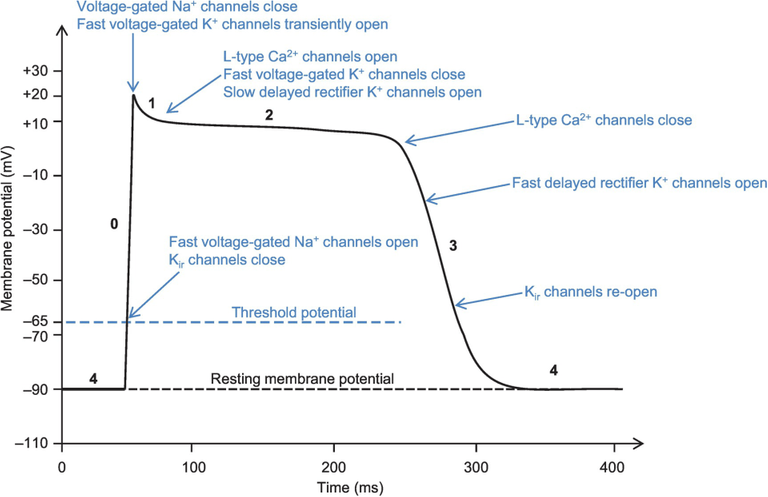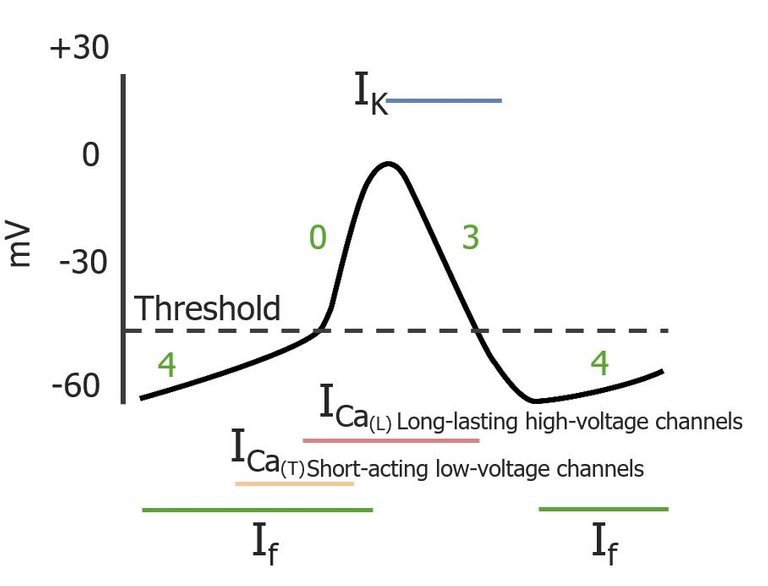Hi ! It feels good to be here after a long time. I just came across a "funny current" while going through my cardiovascular course. And the best part is because of this current your heart is functioning from beat to beat.
Heart's pumping action is regulated by the electrical conduction system that coordinates the contractions of all the four chambers of heart. The heart usually contains the contractile cells (99%) and autorhytmic cells (1%). And this autorhythmic cells are dependent on the Funny Current and funny channels. These cells don't rely on stimuli rather it is auto-stimulated. It generates its own action potential. So even you take your heart out of body, the autorhythmic cells function independent of any stimuliAction Potential
Basically, lets see the basic of normal cardiac muscle (myocyte) action potential where the neurons signal and communicate to each other via synapse making the heart contract. Generally, it is divided into five phase
Action Potential - [Source]
Phase 4: (during myocyte at rest) the cardiac muscle has negative resting membrane potential (-85mV to -90mV)because the interior of the cell has negative voltage than the exterior having the positive voltage. This is all maintained by voltage gated ion channels and ion pumps which are present in the cell membrane.
Phase 0: When some stimulus arrives, all the positive charge (Na+) flows inside the cell and accumulates until the threshold potential is reached. When more Na+ influx occurs, more and more fast gated channels open and more Na+ is influxed (positive feedback mechanism) making the upward swinging of the curve known as depolarization Phase
Phase 1: When it reaches to maximum the Sodium (Na+) gates closes, Calcium (Ca)gated and fast gated Potassium (K+) channel open making efflux of K+ channel out of the cell and mild influx of Ca. Due to this, the curve falls down a little.
Phase 2: In this phase the Ca++ entering the myocyte triggers the sarcoplasmic reticulum to generate more Ca++ for myocyte contraction .This phase is called Plateau Phase (0 mV) because the Ca++ channel getting inside the cell maintains the curve as somewhat a straight line as there is efflux of K+ ion by slow rectified K+ channel. Here, the Fast K+ channel closes.
Phase 3: The Ca++ channels close and and slow gated K+ channel is working. This makes K+ move outside the myocyte making the myocyte relax. A fall in slope of the curve is obtained which is also called as hyperpolarization phase.
This again reaches to the phase 4 resting membrane potential phase( phase 4) until next stimuli comes and kicks in for phase 0

Electrical Activity Source
Heart Electrical System
In heart, the electrical stimulus is generated by various nodes. These nodes happens to be specialized nervous tissue compared to the nervous tissue of other parts of body. At first, electrical impulses are generated in the SA node (sinoatrial node) contracting the two atrium. This then further travels to the atrioventricular node which travels through bundle of his diving to right and left bundle branch and later to purkinje fibers contracting the lower two ventricles.
"Funny current" (If)is just present in the SA node and not in the myocytes. Since SA node is called as the Pacemaker of heart, (If) plays a major role in determining the heart rate and rhythmicity of the heart. It was discovered by Sir Di Francesco in 1979 which he called as pacemaker current. These are inward current generated through funny channels (located on SA node) which gets activated in hyperpolarized state. Lets simplify by looking at the Action potential in the Pacemaker how If is playing the role in determining the rate .

Pacemaker Action Potential [Source]
In the phase 4 : The funny channels open during the hyperpolarized state which facilitates the inward movement of Na+ currents. This is what is called "Funny Current" . This If potentiates the membrane potential to spontaneously depolarize marking as the initiator of Phase 4. Then transient T- type Ca++ channel open at around -50 mV further depolarizing the cell. Then the second type long lasting L-type Ca+ channel open at around -40 mV. When the threshold is reached, it goes to phase 0.
Phase 0 : Depolarization starts at between -30 mV to -40 mV . This is due to the opening of inward current through L type Ca+ channel. And at this stage both the Funny current and T-type Ca++ channel close .
Phase 3: L- type Ca++ channel closes and K+ channel open and start to efflux K+ outside the cell. This causes hyperpolarization. K+ channel maintains the pre-potential state also called as K-decay (Ik decay).
When hyperpolarization state is reached , the slow Na+ channel (Funny current) again open and autorhytmic is maintained. Funny current opposes the hyperpolarized state stops it.
Since the pacemaker cells have less negative resting membrane potential (-60mV), the fast gated Na+ channel which need (-85 mV-90 mV) as of cardiac myocyte is permanently inactivated. Only the slow gated Na+ channels are working . This accounts for automaticity of SA and AV nodes. Even AV node has _If _and due to its longer phase 4, SA node takes first place for determining heart rate due to its short phase 4.
Is there any Clinical Use ?
From above, we can say that If is activated through voltage hyperpolarization. Even from sympathetic autonomic activation ( fight, flight ,fright response)which increases the cyclic adenosine monophosphate (cAMP) known as secondary messenger activates the If. The structure of _If _channels have hyperpolarization-activated cyclic nucleotide-gated (HCN) channel . This HCN structure has four isoforms till now and HCN type 4 is mostly expressed in the SA node.
So what about the parasympathetic stimulation ? It is just opposite. It inactivates the Funny current ! Sinus bradycardia !! i.e decreased heart rate
These isoforms knowledge have helped in production of drugs against the cardiac pacemaker rather the the neuronal cells of nervous system and effects on nervous neurons. Due to the molecular features and composition has helped in producing drug specific to the particular and different pacemakers of heart. Even for now HCN clones have been useful in developing the biological pacemaker for rhythm control in heart failure and arrhythmic patient.
Currently, Ivabradine drug has been implicated which acts by slowing the depolarization and selectively inhibiting the funny channels. It is still now the drug of choice in Chronic heart failure and choric angina who cannot take B-blokers .
Thank you all for reading.
Reference:
Anatomy and function of the heart's electrical system
The Funny current - Springerlink
Funny Channel in treatment of cardiac rhythm and mode of action
Science Direct- History and Working of funny current
This makes me wonder if we literally have a funny bone.
Yup. I checked. We do.
Yes there is the funny bone but its a misnomer , its a nerve
Its the ulnar nerve which is giving sensation to the medial two finger (little and ring) giving the tingling sensation when triggered !
That's funny!
Do you know why it is called a funny current? I am wondering about the origins of the name. Thanks in advance for your answer. Cheers!
See my comment above (or below, who knows). Turns out we have lots of funny things inside us!
Ahaha! I actually knew about the funny bone. This comes with such a suffering situation...
Many ions and channels in heart are activated on depolarized state (activated state) . But only this Na+ Channel current also called “funny current” gets activated on hyperpolarized state (inanctivated state). Its effect has just opposite to other current in heart, thats why its called a funny current !
Was waiting for someone to ask on why its called funny current but you did thanks a lot professor !
Thanks a lot for this answer. So the reason is really the fact that this current has a "funny" behaviour relative to the other currents. Cool to know! :)
The rewards earned on this comment will go directly to the person sharing the post on Twitter as long as they are registered with @poshtoken. Sign up at https://hiveposh.com.
Thanks for sharing ! Means a lot to me :)
Thanks for your contribution to the STEMsocial community. Feel free to join us on discord to get to know the rest of us!
Please consider delegating to the @stemsocial account (85% of the curation rewards are returned).
You may also include @stemsocial as a beneficiary of the rewards of this post to get a stronger support.
Congratulations @medical-hall! You have completed the following achievement on the Hive blockchain and have been rewarded with new badge(s):
Your next target is to reach 600 upvotes.
You can view your badges on your board and compare yourself to others in the Ranking
If you no longer want to receive notifications, reply to this comment with the word
STOPCheck out the last post from @hivebuzz:
Support the HiveBuzz project. Vote for our proposal!